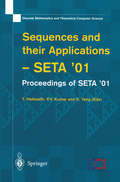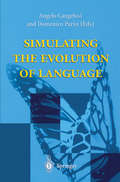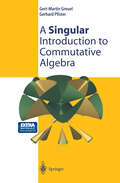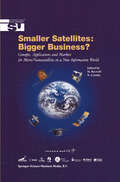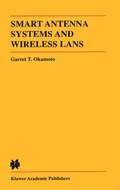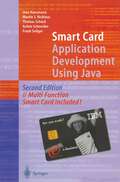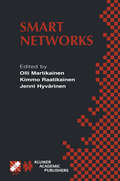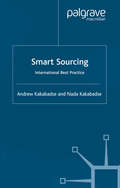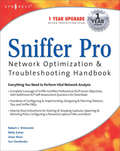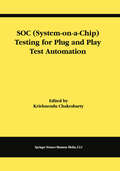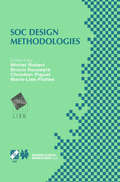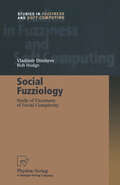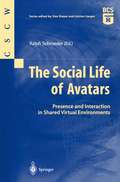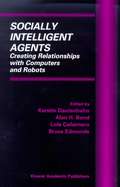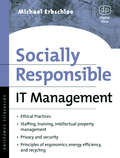- Table View
- List View
The Semantic Web - ISWC 2002: First International Semantic Web Conference, Sardinia, Italy, June 9-12, 2002, Proceedings (Lecture Notes in Computer Science #2342)
by Ian Horrocks James HendlerThe Semantics and Proof Theory of the Logic of Bunched Implications (Applied Logic Series #26)
by David J. PymThis is a monograph about logic. Specifically, it presents the mathe matical theory of the logic of bunched implications, BI: I consider Bl's proof theory, model theory and computation theory. However, the mono graph is also about informatics in a sense which I explain. Specifically, it is about mathematical models of resources and logics for reasoning about resources. I begin with an introduction which presents my (background) view of logic from the point of view of informatics, paying particular attention to three logical topics which have arisen from the development of logic within informatics: • Resources as a basis for semantics; • Proof-search as a basis for reasoning; and • The theory of representation of object-logics in a meta-logic. The ensuing development represents a logical theory which draws upon the mathematical, philosophical and computational aspects of logic. Part I presents the logical theory of propositional BI, together with a computational interpretation. Part II presents a corresponding devel opment for predicate BI. In both parts, I develop proof-, model- and type-theoretic analyses. I also provide semantically-motivated compu tational perspectives, so beginning a mathematical theory of resources. I have not included any analysis, beyond conjecture, of properties such as decidability, finite models, games or complexity. I prefer to leave these matters to other occasions, perhaps in broader contexts.
The Semantics of Relationships: An Interdisciplinary Perspective (Information Science and Knowledge Management #3)
by R. Green C. A Bean Sung Hyon Sung Hyon MyaengThe genesis of this volume was the participation of the editors in an ACMlSIGIR (Association for Computing Machinery/Special Interest Group on Information Retrieval) workshop entitled "Beyond Word Relations" (Hetzler, 1997). This workshop examined a number of relationship types with significance for information retrieval beyond the conventional topic-matching relationship. From this shared participation came the idea for an edited volume on relationships, with chapters to be solicited from researchers and practitioners throughout the world. Ultimately, one volume became two volumes. The first volume, Relationships in the Organization of Knowledge (Bean & Green, 200 I), examines the role of relationships in knowledge organization theory and practice, with emphasis given to thesaural relationships and integration across systems, languages, cultures, and disciplines. This second volume examines relationships in a broader array of contexts. The two volumes should be seen as companions, each informing the other. As with the companion volume, we are especially grateful to the authors who willingly accepted challenges of space and time to produce chapters that summarize extensive bodies of research. The value of the volume clearly resides in the quality of the individual chapters. In naming this volume The Semantics of Relationships: An Interdisciplinary Perspective, we wanted to highlight the fact that relationships are not just empty connectives. Relationships constitute important conceptual units and make significant contributions to meaning.
Sensor Based Intelligent Robots: International Workshop, Dagstuhl Castle, Germany, October 15-20, 2000. Selected Revised Papers (Lecture Notes in Computer Science #2238)
by Gregory D. Hager Henrik I. Christensen Horst Bunke Rolf KleinRobotics is a highly interdisciplinary research topic, that requires integration of methods for mechanics, control engineering, signal processing, planning, gra- ics, human-computer interaction, real-time systems, applied mathematics, and software engineering to enable construction of fully operational systems. The diversity of topics needed to design, implement, and deploy such systems implies that it is almost impossible for individual teams to provide the needed critical mass for such endeavors. To facilitate interaction and progress on sensor-based intelligent robotics inter-disciplinary workshops are necessary through which - depthdiscussioncanbeusedforcrossdisseminationbetweendi?erentdisciplines. The Dagstuhl foundation has organized a number of workshops on Mod- ing and Integration of Sensor Based Intelligent Robot Systems. The Dagstuhl seminars take place over a full week in a beautiful setting in the Saarland in Germany. The setting provides an ideal environment for in-depth presentations and rich interaction between the participants. This volume contains papers presented during the fourth workshop held - tober 15–20, 2000. All papers were submitted by workshop attendees, and were reviewed by at least one reviewer. We wish to thank all of the reviewers for their invaluable help in making this a high-quality selection of papers. We gratefully acknowledge the support of the Schloss Dagstuhl Foundation and the sta? at Springer-Verlag. Without their support the production of this volume would not have been possible.
Sequences and their Applications: Proceedings of SETA ’01 (Discrete Mathematics and Theoretical Computer Science)
by T. Helleseth P. V. Kumar K. YangPseudorandom sequences have widespread applications, for instance, in spread spectrum, code division multiple access, optical and ultrawide band communication systems, as well as in ranging systems global positioning systems, circuit testing and stream ciphers. Such sequences also have strong ties to error-correcting codes.This volume contains survey and research papers on sequences and their applications. It brings together leading experts from discrete mathematics, computer science and communications engineering, and helps to bridge advances in these different areas. Papers in this volume discuss the theory of sequences and their applications in cryptography, coding theory, communications systems, numerical computation and computer simulation.
Service Providers: ASPs, ISPs, MSPs, and WSPs (Technology Briefs Series #21)
by Mary Helen GillespieA strategic guide to mastering service provider relationships Well-known business management consultant and Boston Globe columnist Mary Helen Gillespie helps business and IT managers navigate through the confusing technology-driven landscape of service providers. Offering insight into the points of view for both the service provider and client, Gillespie guides readers through available services, from Internet access and applications service providers, to wireless and networking services and IT management services. Readers will find business models, overviews of the enabling technologies, coverage of economic and management issues, and clear descriptions of service offerings within each provider type. Most importantly, decision makers will be able to choose the right service provider to meet their needs and develop strategic partnerships when outsourcing non-core business functions.
Shape Interrogation for Computer Aided Design and Manufacturing
by Nicholas M. Patrikalakis Takashi MaekawaShape interrogation is the process of extraction of information from a geometric model. It is a fundamental component of Computer Aided Design and Manufacturing (CAD/CAM) systems. This book provides a bridge between the areas geometric modeling and solid modeling. Apart from the differential geometry topics covered, the entire book is based on the unifying concept of recasting all shape interrogation problems to the solution of a nonlinear system. It provides the mathematical fundamentals as well as algorithms for various shape interrogation methods including nonlinear polynomial solvers, intersection problems, differential geometry of intersection curves, distance functions, curve and surface interrogation, umbilics and lines of curvature, and geodesics.
Sheaves, Games, and Model Completions: A Categorical Approach to Nonclassical Propositional Logics (Trends in Logic #14)
by Silvio Ghilardi M. ZawadowskiThis book is an example of fruitful interaction between (non-classical) propo sitionallogics and (classical) model theory which was made possible due to categorical logic. Its main aim consists in investigating the existence of model completions for equational theories arising from propositional logics (such as the theory of Heyting algebras and various kinds of theories related to proposi tional modal logic ). The existence of model-completions turns out to be related to proof-theoretic facts concerning interpretability of second order propositional logic into ordinary propositional logic through the so-called 'Pitts' quantifiers' or 'bisimulation quantifiers'. On the other hand, the book develops a large number of topics concerning the categorical structure of finitely presented al gebras, with related applications to propositional logics, both standard (like Beth's theorems) and new (like effectiveness of internal equivalence relations, projectivity and definability of dual connectives such as difference). A special emphasis is put on sheaf representation, showing that much of the nice categor ical structure of finitely presented algebras is in fact only a restriction of natural structure in sheaves. Applications to the theory of classifying toposes are also covered, yielding new examples. The book has to be considered mainly as a research book, reporting recent and often completely new results in the field; we believe it can also be fruitfully used as a complementary book for graduate courses in categorical and algebraic logic, universal algebra, model theory, and non-classical logics. 1.
Sicherheit und Kryptographie im Internet: Von sicherer E-Mail bis zu IP-Verschlüsselung
by Jörg SchwenkBesonderen Wert legt der Autor auf die Darstellung, wie bekannte kryptographische Verfahren an die jeweiligen Erfordernisse der Internet-Dienste angepasst wurden.
Sicherheit und Verfügbarkeit in Echtzeit- und Automatisierungssystemen: Fachtagung der GI-Fachgruppe 4.4.2 Echtzeitprogrammierung, PEARL Boppard, 28./29. November 2002 (Informatik aktuell)
by Peter Holleczek Birgit Vogel-HeuserSimilarity and Compatibility in Fuzzy Set Theory: Assessment and Applications (Studies in Fuzziness and Soft Computing #93)
by Valerie V. Cross Thomas A. SudkampAssessing the degree to which two objects, an object and a query, or two concepts are similar or compatible is a fundamental component of human reasoning and consequently is critical in the development of automated diagnosis, classification, information retrieval and decision systems. The assessment of similarity has played an important role in such diverse disciplines such as taxonomy, psychology, and the social sciences. Each discipline has proposed methods for quantifying similarity judgments suitable for its particular applications. This book presents a unified approach to quantifying similarity and compatibility within the framework of fuzzy set theory and examines the primary importance of these concepts in approximate reasoning. Examples of the application of similarity measures in various areas including expert systems, information retrieval, and intelligent database systems are provided.
Simulating the Evolution of Language
by Angelo Cangelosi Domenico ParisiThis book is the first to provide a comprehensive survey of the computational models and methodologies used for studying the evolution and origin of language and communication. Comprising contributions from the most influential figures in the field, it presents and summarises the state-of-the-art in computational approaches to language evolution, and highlights new lines of development.Essential reading for researchers and students in the fields of evolutionary and adaptive systems, language evolution modelling and linguistics, it will also be of interest to researchers working on applications of neural networks to language problems. Furthermore, due to the fact that language evolution models use multi-agent methodologies, it will also be of great interest to computer scientists working on multi-agent systems, robotics and internet agents.
A Singular Introduction to Commutative Algebra
by Gert-Martin Greuel Gerhard PfisterThis book can be understood as a model for teaching commutative algebra, and takes into account modern developments such as algorithmic and computational aspects. As soon as a new concept is introduced, the authors show how the concept can be worked on using a computer. The computations are exemplified with the computer algebra system Singular, developed by the authors. Singular is a special system for polynomial computation with many features for global as well as for local commutative algebra and algebraic geometry. The book includes a CD containing Singular as well as the examples and procedures explained in the book.
Smaller Satellites: Concepts, Applications and Markets for Micro/Nanosatellites in a New Information World (Space Studies #6)
by M. RycroftY. Fujimori, Symposium Programme Committee Chair, and Faculty Member, International Space University e-mail: fujimori@isu.isunet.edu M.Rycroft, Faculty Member, International Space University e-mail: rycroft@isu.isunet.edu N. Crosby, International Space University e-mail: norma@bock-crosby.fsbusines.co.uk For the sixth annual ISU Symposium the theme was "Smaller Satellites: Bigger Business? Concepts, Applications and Markets for Micro/Nanosatellites in a New Information World". Thus, the Symposium addressed the crucial question: are small satellites the saviour of space programmes around the world It did this from the unique perspective of the International Space today? University - the interdisciplinary, international and intercultural perspective. This Symposium brought together a variety of people working on small satellites - engineers, scientists, planners, providers, operators, policy makers and business executives, together with representatives from regulatory bodies, from national and international organizations, and from the finance sector, and also entrepreneurs. Discussion and debate were encouraged, based on the papers presented and those published here.
Smart Antenna Systems and Wireless LANs (The Springer International Series in Engineering and Computer Science #474)
by Garret OkamotoThis book concerns two major topics, smart antenna systems and wireless local-area-networks (LANs). For smart antenna systems, it d- cusses the mechanics behind a smart antenna system, the setup of a smart antenna experimental testbed, and experimental and computer simulation results of various issues relating to smart antenna systems. For wireless LAN systems, it discusses the IEEE 802.11 worldwide wi- less LAN standard, the operation of a wireless LAN system, and some of the technical considerations that must be overcome by a wireless LAN system designer. These two topics are combined in the discussion of the Smart Wireless LAN (SWL) system, which was designed to achieve the benefits which smart antenna systems can provide for wireless LAN systems while still remaining compatible with the 802.11 wireless LAN standard. The design of SWL calls for the replacement of the conv- tional wireless LAN base station (which are called access points in the 802.11 documentation) with an SWL base station, while leaving the - dividual terminal operation as unchanged as possible.
Smart Card Application Development Using Java
by Uwe Hansmann Martin S. Nicklous Thomas Schäck Achim Schneider Frank SeligerSmart cards play an increasingly important role in everyday life. We encounter them as credit cards, loyalty cards, electronic purses, health cards, ands as secure tokens for authentication or digital signatures. Their small size and the compatibility of their form with the magnetic stripe card make them ideal carriers of personal information such as secret keys, passwords, customization profiles, and medical emergency information. This book provides a guide for the rapid development of smart card applications using Java and the OpenCard Framework. It gives you the basic information you need about smart cards and how they work. A smart card provided with the book will help you to obtain first-hand experience.
Smart Networks: IFIP TC6 / WG6.7 Seventh International Conference on Intelligence in Networks (SmartNet 2002) April 8–10, 2002, Saariselkä, Lapland, Finland (IFIP Advances in Information and Communication Technology #84)
by JenniHyvärinen KimmoRaatikainen OlliMartikainenSmart Networks comprises the proceedings of Smartnet'2002, the seventh conference on Intelligence in Networks, which was sponsored by the International Federation for Information Processing (IFIP) and organized by Working Group 6.7. It was held in Saariselkä, Finland, in April 2002. The conference series closely reflects the developments in networking.
Smart Sourcing: International Best Practice
by A. KakabadseWith a growing market currently in excess of $150 billion, outsourcing has become a critical boardroom agenda. Meeting this challenge, Andrew and Nada Kakabadse answers key boardroom questions: Q What will be the key areas of outsourcing in the future? A IT and HR! Q What supplier relationships work best: partnerships, joint ventures? A No, the preferred single supplier still provides best service! Q Does well-managed outsourcing make a difference? A Substantially, both strategic and operational! As one of the largest international surveys on outsourcing, Smart Sourcing highlights what it takes to be "outsource ready" and thus become a high performing company. The message is focus on your strengths and know how to use others in order to clearly differentiate!
Sniffer Pro Network Optimization & Troubleshooting Handbook
by SyngressSniffer Network Optimization and Troubleshooting Handbook introduces the reader to the vast functionality of the suite of Sniffer Solutions from Network Associates but ultimately focuses on the affordable and most widely used Sniffer Product - Sniffer Pro LAN Network Analyzer. This book begins with the basic features of Sniffer Pro LAN and then moves the reader through the impressive tips and tools available for gathering data, analyzing, troubleshooting, resolving and securing problems on their network. Sniffer from Network Associates is a suite of tools including Sniffer Portable Analysis Suite, Sniffer Distributed Analysis Suite, Sniffer Reporting, Sniffer Optical, and Sniffer Wireless. With a clear market leadership, Sniffer Solutions are employed in over 80% of the enterprise networks of the Fortune 100. Sniffer has also received wide industry acclaim from the experts and its everyday users. In 2000 Sniffer was named one of the 10 most computer products of the decade by Network Computing Magazine. It also received the "Editor's Choice" award from PC Magazine during the second quarter of 2001. Over 60,000 individuals have taken advantage of the educational services offered by Sniffer Technologies - aptly named Sniffer University. Coupled with the introduction of the Sniffer Certified Professional Program (SCPP) as a replacement for the popular CNX (Certified Network Expert) certification, an aptitude with Sniffer Solutions is a "must-have" for system administrators.Offers comprehensive coverage of Sniffer Pro LANSupplemental study materials for the SCPP certification track. As of April 2001, the CNX certifications track became inactive. Current CNXs looking to update their certifications to the new SCPP track are going to need to bring themselves up to speed on the new offerings from the Sniffer family of products before desertificationUp to the Minute Web-based Support. Once the reader understands the concepts of network hardware, configuration, and implementation, they can receive up-to-the minute links, white papers, and analysis for one year at solutions@syngress.com
SOC (Frontiers in Electronic Testing #21)
by Krishnendu ChakrabartySystem-on-a-Chip (SOC) integrated circuits composed of embedded cores are now commonplace. Nevertheless, there remain several roadblocks to rapid and efficient system integration. Test development is seen as a major bottleneck in SOC design and manufacturing capabilities. Testing SOCs is especially challenging in the absence of standardized test structures, test automation tools, and test protocols. In addition, long interconnects, high density, and high-speed designs lead to new types of faults involving crosstalk and signal integrity. SOC (System-on-a-Chip) Testing for Plug and Play Test Automation is an edited work containing thirteen contributions that address various aspects of SOC testing. SOC (System-on-a-Chip) Testing for Plug and Play Test Automation is a valuable reference for researchers and students interested in various aspects of SOC testing.
SOC Design Methodologies: IFIP TC10 / WG10.5 Eleventh International Conference on Very Large Scale Integration of Systems-on-Chip (VLSI-SOC’01) December 3–5, 2001, Montpellier, France (IFIP Advances in Information and Communication Technology #90)
by Michel Robert Bruno Rouzeyre Christian Piguet Marie-Lise FlottesThe 11 th IFIP International Conference on Very Large Scale Integration, in Montpellier, France, December 3-5,2001, was a great success. The main focus was about IP Cores, Circuits and System Designs & Applications as well as SOC Design Methods and CAD. This book contains the best papers (39 among 70) that have been presented during the conference. Those papers deal with all aspects of importance for the design of the current and future integrated systems. System on Chip (SOC) design is today a big challenge for designers, as a SOC may contain very different blocks, such as microcontrollers, DSPs, memories including embedded DRAM, analog, FPGA, RF front-ends for wireless communications and integrated sensors. The complete design of such chips, in very deep submicron technologies down to 0.13 mm, with several hundreds of millions of transistors, supplied at less than 1 Volt, is a very challenging task if design, verification, debug and industrial test are considered. The microelectronic revolution is fascinating; 55 years ago, in late 1947, the transistor was invented, and everybody knows that it was by William Shockley, John Bardeen and Walter H. Brattein, Bell Telephone Laboratories, which received the Nobel Prize in Physics in 1956. Probably, everybody thinks that it was recognized immediately as a major invention.
Social Fuzziology: Study of Fuzziness of Social Complexity (Studies in Fuzziness and Soft Computing #107)
by Vladimir Dimitrov Bob HodgeFuzziology studies the fuzziness inherent in what we know about ourselves, the sources and nature of our experience, our thoughts and feelings, drives for understanding and urges to create and realise our potential. This kind of fuzziness is at the core of our existence, at the essence of our humanness. It affects any field of human activity, be it mathematical study of fuzzy equations and fuzzy integrals; engineering design and implementation of fuzzy logic-based methodologies; fuzzy control systems or fuzzy robots. Social fuzziology investigates the role of fuzziness in understanding the dynamic complexity of human existence in the social world. It is a study of the nexus between the complex demands of life -individual and social -and the fuzziness of thinking. Since human evolution over 2 billion years has seen the co-evolution of social complexity with human language and thought, it is likely that the fuzziness of language and thought is especially intimately formed by the demands of social complexity, just as social complexity is sustained by the inherent fuzziness of language and thought. Social fuzziology is not simply one field of application of fuzziology. Given the initial state of the development of fuzziology, social fuzziology needs to develop hand in hand with fuzziology, each helping to advance the other.
The Social Life of Avatars: Presence and Interaction in Shared Virtual Environments (Computer Supported Cooperative Work)
by RalphSchroederVirtual reality (VR) technology has been developed commercially since the early 1990s [1]. Yet it is only with the growth of the Internet and other high-bandwidth links that VR systems have increasingly become networked to allow users to share the same virtual environment (VE). Shared YEs raise a number of interesting questions: what is the difference between face-to-face interaction and interaction between persons inside YEs? How does the appearance of the "avatar" - as the graphical representation of the user has become known - change the nature of interaction? And what governs the formation of virtual communities? This volume brings together contributions from social scientists and computer scientists who have conducted research on social interaction in various types of YEs. Two previous volumes in this CSCW book series [2, 3] have examined related aspects of research on YEs - social navigation and collaboration - although they do not always deal with VRIVEs in the sense that it is used here (see the definition in Chapter 1). The aim of this volume is to explore how people interact with each other in computer-generated virtual worlds.
Socially Intelligent Agents: Creating Relationships with Computers and Robots (Multiagent Systems, Artificial Societies, and Simulated Organizations #3)
by Kerstin Dautenhahn Alan H. Bond Bruce Edmonds Lola CanameroSocially situated planning provides one mechanism for improving the social awareness ofagents. Obviously this work isin the preliminary stages and many of the limitation and the relationship to other work could not be addressed in such a short chapter. The chief limitation, of course, is the strong commitment to de?ning social reasoning solely atthe meta-level, which restricts the subtlety of social behavior. Nonetheless, our experience in some real-world military simulation applications suggest that the approach, even in its preliminary state, is adequate to model some social interactions, and certainly extends the sta- of-the art found in traditional training simulation systems. Acknowledgments This research was funded by the Army Research Institute under contract TAPC-ARI-BR References [1] J. Gratch. Emile: Marshalling passions in training and education. In Proceedings of the Fourth International Conference on Autonomous Agents, pages 325–332, New York, 2000. ACM Press. [2] J. Gratch and R. Hill. Continous planning and collaboration for command and control in joint synthetic battlespaces. In Proceedings of the 8th Conference on Computer Generated Forces and Behavioral Representation, Orlando, FL, 1999. [3] B. Grosz and S. Kraus. Collaborative plans for complex group action. Arti?cial Intelli gence, 86(2):269–357, 1996. [4] A. Ortony, G. L. Clore, and A. Collins. The Cognitive Structure of Emotions. Cambridge University Press, 1988. [5] R.W.PewandA.S.Mavor,editors. Modeling Human and Organizational Behavior. National Academy Press, Washington D.C., 1998.
Socially Responsible IT Management
by Michael ErbschloeSocially Responsible IT Management shows IT professionals how to overcome the social crisis that has resulted from the wide-spread use of information technology. By responsibly managing security threats, protecting individual privacy, reducing hazardous waste, and minimizing other negative effects on IT staff and computer users, as well as ordinary citizens around the world, IT professionals can benefit the society at large and reap rewards for their own organizations as well.Scandals at Enron, Andersen, Sotheby's and Christie's, Merrill Lynch, and Tyco are fueling a crisis of confidence in business. Regulators, voters, investors, customers, and employees are demanding that businesses be more socially responsible. Rhetoric is not enough, all organizations need to demonstrate that they are living up to social expectations. Erbschloe shows managers how to take charge of key aspects of their IT operations and follow a morally, ethically, and legally correct path to success.· Supported by author speaking tour and "Computer Economics" website, www.computereconomics.com · Step-by-step instructions on how to accomplish objectives of privacy and security· Explains principles of ergonomics, energy efficiency, and recycling that can bring return on investment




